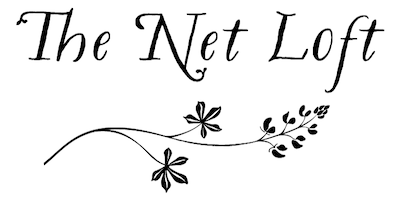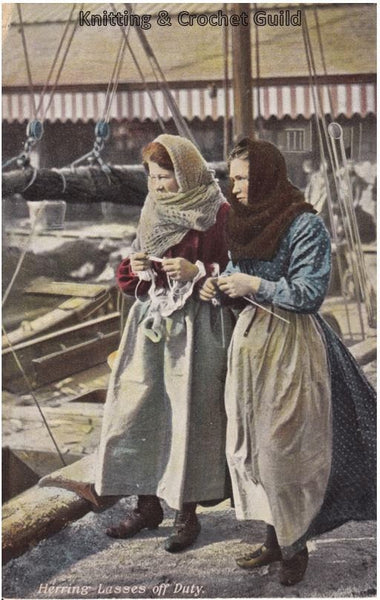Cordova Gansey Project - The Long Story (cont.) #3
Share
# 3 - Friends in a Faraway Place
We all have our reasons for finding our way to a faraway place. Sometimes we are simply born there, and other times we follow an inkling or follow a friend, for fun, for a job, or both. Sometimes it is for a long while, and sometimes it may just be for a week or two. Regardless of the time spent, these places off the beaten path change us, and we are not quite the same as we were, or would have been, without the influence these kind of places have on us.

Cordova is such a place one has to come to with intention. It is not on the way to someplace else, but rather a destination one must choose. It takes a little extra effort, but definitely worth the journey. Sometimes around the Net Loft Knitting Table the conversation arises as to "what brought you here", "how did you come to be in Cordova?" I always love to hear the different stories and responses as they are shared.
For my husband, Bob, he had a friend who had gone to Alaska and came back with tales of life on a fishing boat. Like his grandfather Charles on the right in the photo above, who had left the comforts of home in England during the gold rush in search of adventure and fortune in Alaska, Bob and his friend Kenny headed northward on their own sojourn, and found themselves in the town of Cordova, Alaska, just months after the 1964 earthquake.

After walking the docks, these greenhorns both found jobs as deckhands on two different salmon fishing seine boats, and joined the ranks of the fishing migrant summer population.
Cordova has long experienced this swell in numbers in response to the return of the salmon. Captains, crewmen, and cannery workers fill the town, just like the salmon fill the sound, streams, and rivers. The town bustles with activity as they gear up for another season. It is the fish that draw them here. The scenery and the surroundings bid them to stay, or be compelled to return, such as these two friends, Kenny and Bob.

And so for me, it was an inkling and a long standing desire that was MY reason and what inevitably led me half way around the world to the Shetland Islands. Perhaps it was that photo in my geography book in the 5th grade with the children standing by the Shetland pony, or the yoked Shetland sweater my best friend at camp in Colorado would wear that I always loved. The sheep, the yarn, the knitting, and from far away, it just drew me to it and just seemed like a place that I would love, although it was a long time wanting to go before finally culminated in a getting to go. And then, it happened, I set my compass heading purposely for this faraway land and made the journey, without really thinking too much about it beforehand.
As a migratory individual, I generally consider home as the place where I am at that moment in time, more of a state of mind than a physical condition...never a "local", but always "at home". So it was, that in just a few days, Shetland and my little cottage by the sea with the Shetland ponies in the yard, was now "home", and I settled in and felt my roots sink quickly. Waking up in my new "home" after a good nights sleep, I felt more comfortable and ready for what lay ahead. It was now Wednesday of Shetland Wool Week. I awoke extra early, as I had a special place and activity to reach that were two islands and two ferry journeys away on the far north island of Unst, famous for producing beautiful handspun fine lace and the northernmost inhabited island in the British Isles. I was signed up for an all day lace design class with the “Lace Knitters of Unst”, and because of the ferries, timing was criticaI.
Today's journey began via the north entrance to the town of Aith on a narrow back road. There were no cars on this single lane byway that wound up and down and through the mountains and heathered hills where sheep roamed on and along the roadside. As I ventured down the lane, it was so beautiful my heart was literally fluttering with excitement, and in the early morning light, the landscape virtually took my breath away. There was so much adrenalin pumping through my veins, I felt like I was going to burst. Off the beaten path to a faraway place, definitely worth the journey.
A few hours and many miles later, I arrived at the Unst Heritage Center for my class. The small center had been a school at one time, but now had an assortment of displays on Unst history, lace knitting, as well as a small gift shop of books, knitting patterns and knitted items. The entrance to our classroom had this lovely hanging handknit lace framing the top of the doorway. Our class met on a table they set right between the small glass cases and living history vignettes with old style mannequins dressed in their period clothing. All day, I would catch a glimpse of them with the corner of my eye and forget they weren't real. It was as though these characters of the past were there overseeing our lessons. Squeezed into the room alongside us were racks with more of the ganseys on display from the Moray Firth Gansey Project that were on exhibit in Shetland for Wool Week. We were literally surrounded with historical knitting in our close quarters.
The day's workshop was led by Hazel Laurenson. With just three other students in the class and lots of personal attention, the day was one that is deeply etched into my memory. My heart felt laden with so much of the experience to absorb. I didn’t want to miss a drop of it. I recently stumbled into a blog post by one of the other women that was in our small group. She felt a similar response to her experience that it was one of those very special days in her life to long remember.
Hazel was a patient and kind instructor. During her introduction, as she gave us a lesson in Shetland lace history and structure, she pulled out a pillow case filled with these acid free tissue paper wrapped rolls, and unrolled piece after piece of beautiful hand knit lace. Clearly I was in the presence of a living treasure.
So interesting to hear her care and concerns that the craft not be lost. She mentioned that knitting was no longer taught in the schools and her fears that the next generations would not or were not interested in these old knitting ways. This was a genuine concern that I heard over and again throughout my time there, this heartfelt desire for their knitting traditions to not fade, especially on the island and throughout Shetland, hard to believe with so much excitement and interest during wool week. I also thought of how Ravelry has reignited and reintroduced some of these traditions and fine knitting to a new generation, and though maybe not so fine of yarn, some of the same ideas conceptually are being taken on throughout the world now and the incredible exchange of pattern and ideas via the internet.

After carefully studying and fondling her beautiful samples, we jumped right into our knitted lace projects using Jamieson Cobweb Laceweight Shetland Wool. We had a choice of two different sizes. I was actually surprised at how "sensible" and simple the knitting was structured. It was so logical and with the knitter in mind.
During our tea break, I had time to look at the Moray Firth ganseys up close. On each garment was a tag and each tag told the origin of that particular garment. What is interesting about knitting is the person and the place and the situations that surround each project. I really liked getting to take a closer look at more of these sweaters that had caught my eye and that had stirred up my attention a couple days earlier. I found that they had been collected from around Scotland and I was impressed by the fine gauge knitting, intricate design, and workmanship in each piece.




During lunch while others were off in the other room eating, I wandered around and took time to study the display cases searching for more details of Unst history in the quiet of this little museum. The mesh between fishing and knitting on this distant island continued to unfold, and I was interested in finding our more on the subject. Not knowing too much yet, I wondered to myself, where were these fishermen that used to line the coast? It all seemed very still here and sparsely populated. I am sure others knew, but this was new history for me.
I soon learned that Baltasound, the main village in Unst, once vied with Lerwick as the top herring port in the boom years 1880-1925. During the ‘season’ the population of 500 rose to 10,000 with the influx of gutters and coopers, supporting some 600 boats. Our town of Cordova may more than double or possibly triple, but this was twenty times the nonseasonal population. What a major change in the dynamic of the town this must have been. Where did everyone live? Where did everyone go? Was fishing still happening even if the boom years were gone?
I wanted to know the details and I was especially intrigued by the women who were the laborists in this open air on the docks cannery of sorts. I continued to be drawn to the photos of the“herring or fisher lassies”, who would gut the fish and pack the barrels. I wondered who they were and how they felt or what they thought about this faraway place that provided their living, and their part in this moving mass of people that followed the fish. There was something about those girls with their smiles, and here I was on a faraway island in their fish town gazing at the hills that once were their migrant fishing "home" for those days they were here, moving along with the migration of the fish.
It wasn't just that they were connected to me because we were both tied to fishing, but it was the fishing and the knitting I wanted to know more about. The simple words I found were, "in their spare time, when they were waiting for the fish, they would sing or spend time knitting ganseys and stockings". Those words sounded so wonderful to me. Even with the long hours and hard work, they would sing and knit in their down time. Just for fun, here is one of their songs I found which they also sang as they worked: herring girls song http://www.banffshiremaritime.org.uk/index.php/following-the-herring/herring-gutters-song
I know well this waiting for the fish. The boats go out, the boats come in. As a fish wife, my summer life has been marked by boats going out and coming in, with the weaving in and out of the "Captain" being home and crewmen in the house, alternated with concentrated Net Loft time.










